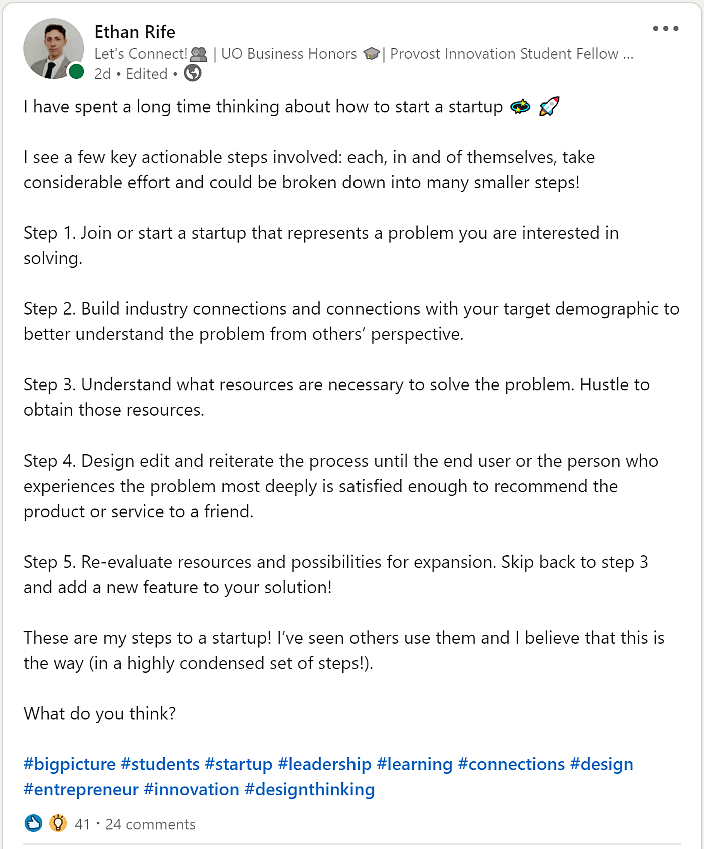I previously shared on LinkedIn a few basic steps to build a startup! In case you missed it, feel free to check it out in the image above. After posting those condensed set of steps and receiving feedback on them, I realized that many people would like to see these concepts expanded. So sit back, relax and enjoy the, still condensed but slightly less so, guide to starting a startup!
Step 1. Join or start a startup that represents a problem you are interested in solving.
When done correctly, this step gets the ball rolling to succeed in all the others. If you truly are passionate about a problem or an idea that you have, pursue it! If there are others who have brought an idea your way and you find it too interesting to walk away from, pursue it! If you just can’t stop thinking about a product you would like to use or wish existed, pursue it!
First steps are always the most difficult because there are so many questions to answer, but as you continue to press onward you will gain a greater understanding. Think of a startup idea as a puzzle. You can visualize the end result but still need to find and assemble the pieces to make it whole! This first step is like taking a long look at the picture on the box and deciding if you want to put in the work to build it.
Step 2. Build industry connections and connections with your target demographic to better understand the problem from others’ perspective.
This second step is also super important! Although it is perfectly okay to spend some of your time working on projects that simply fill your own needs and desires, a startup is intended to scale to meet others’ needs and desires as well. Understanding their problems helps you create a more well rounded solution.
These connections may also come in handy later on down the entrepreneurial journey as potential clients, consultants and even investors! The more people you talk to, the greater chance you will have at finding someone who has the exact resources you may end up needing. This is not to say you should reach out to them just to obtain their resources. In fact it is far more beneficial to approach new connections with a give first mentality. Approaching others with the sole purpose of hearing and helping will help develop a healthy entrepreneurial culture within your community.
Step 3. Understand what resources are necessary to solve the problem. Hustle to obtain those resources.
During step 2, you will likely gain a greater understanding of what you may need to solve this problem or create your dream product. To continue in your own understanding, make sure to do key research on businesses or entities that have solved similar problems. This will help build a point of reference. Remember that you do not need to have it all figured out, entrepreneurship is complex and difficult, you could spend the rest of your life preparing for a venture and end up completely underestimating or miscalculating the necessary inputs. Entrepreneurship is evolutionary by nature and will constantly require you to change your plans without sacrificing your vision.
Once you have a rough idea of what it will take to make your first version of the product or service, work hard to obtain what you need. There are several ways to do this and take into full consideration your own needs as a founder when choosing the way you would like to finance the company. Do you want complete control? Try to avoid equity financing. Do you want others to share your passion and have a stake in your company’s future? Maybe equity financing is the route for you. I could go on forever about financing methods and “lean” launch methods, but the purpose of this is to get the ball rolling!
Step 4. Design, edit and reiterate the process until the end user or the person who experiences the problem most deeply is satisfied enough to recommend the product or service to a friend.
As previously stated, the entrepreneurial process is evolutionary. Between when you first launch your venture and its success will likely be many “pivots” - or changes in strategic direction. Don’t be afraid to pull out parts of your solution that simply do not work. Instead, replace them with new methods and test those methods to validate your hypotheses. Measure as much as you can both qualitatively and quantitatively. Ask questions to your early users or purchasers. Track key metrics that signal satisfaction with your solution. A few examples are: how many times does someone use your product or service after already using it, and how much are they willing to spend on it? You will know that you have found the right solution for the right people, also known as product market fit, when your current users are telling all their friends and family about it.
Step 5. Re-evaluate resources and possibilities for expansion. Skip back to step 3 and add a new feature to your solution!
The entrepreneurial journey never really ends. It always continues onward because true entrepreneurs recognize that there are endless ways to improve this world that we get to live in! In the previous step you were able to find the right solution for a certain group of people who really fell in love with what you created. Now you get to expand upon that and add a new feature to your solution that allows you to help your current user group more or even reach new people!
Once you have thought of something go back to step 3 and run it back. Or take a break and give yourself a high five. There will always be new things to do and new people to help, make sure to care for yourself along the way.

